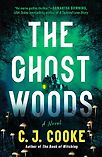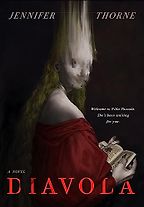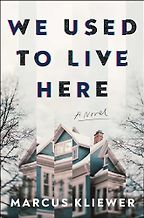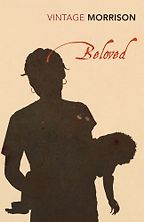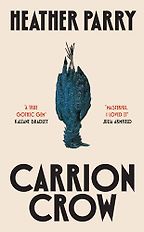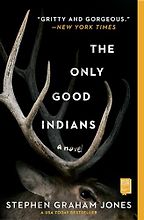So, to begin, what is gothic fantasy?
Gothic fantasy includes elements of ghostliness and of trauma. For me, the Gothic is very much about the goo underneath the forest floor, the stuff that’s hidden from sight, the uncomfortable things, the ghosts of various kinds, the pain… And it’s about the blurry areas, I think, the stuff that’s not black and white, not binary. It’s the liminal space.
Gothic fantasy is a work that is really interested in the supernatural elements of the Gothic. So there’s just a bit more emphasis on the fantasy, on the imagined. It’s a really beautiful collision of genres and worlds.
Let’s dive in with your first choice. Could you introduce Diavola by Jennifer Thorne?
This book is unhinged and hard to describe. It’s the classic haunted house story. There’s the dynamics of a family, and unsettling warnings from local villagers, and the past of the villa that they’re staying in… I loved the sharpness of the writing. It was really intelligent, quick writing, full of depth and despair. And it’s a really unique take on the haunted house trope. I loved what she was doing with the family dynamics, too – I think every family is gothic in its own way!
I love this book. It’s unsettling and smart, and a worthy read indeed for anyone interested in Gothic fantasy.
You mentioned that it’s a fresh take on a haunted house. That’s hard to pull off, with so many takes already. What’s new here?
It’s one thing to have a haunted house described as an old, decrepit mansion, but here we have a remote villa in Italy. She doesn’t rely on atmosphere, at least in terms of darkness and the Victorian era; we move away from that, and instead, we have this Italian villa, a warm and gorgeous country home. So we’re not expecting it – things are not set up for the reader as easily as other novels that employ the haunted house motif. Thorne opens with something that, on the surface, feels more relaxing and cozy and comfortable, and then gradually those elements of darkness come through. It’s creepier because it’s somewhere nice.
There’s another haunted house in your next choice – please tell us about Marcus Kliewer’s We Used To Live Here.
This time, it’s a vast old house that a couple is doing up. They get a knock on the door from a family, a group of strangers, who say, “We used to live here. We grew up here. Can we come in and have a look around?”. It’s a really great premise, starting with that reasonableness – “I used to live here, it holds warm fuzzy memories, can I just…?” – and they come in, but then they stay. One of the kids in the group goes and hides in the basement. It’s so weird and so well paced and so well done.
I don’t actually know how to try to describe what happens in this novel. Even without the issue of spoilers, it’s a complete head melt. I had no clue where it was going, and I just had to keep reading, because it was absolutely insane in the best way. I’ve heard that a Netflix film is being made… I need to read it again, actually, because it’s so messed up.
It made me smile to see that the story started life via the “Nosleep” subreddit… Why do we want to be scared sleepless?
I think it’s wrapped up in intrigue. The element of fear is a heightened sensation, so close to intrigue and to curiosity. It can be very hard to distinguish. Why do we go on rides that are ten storeys high with a drop – it’s a sensation, isn’t it? It’s in some way pleasurable.
Your next choice really blurs the lines between intrigue and fear. Please tell us about the Pulitzer Prize-winning Beloved, by Toni Morrison.
Beloved is hard to categorize. I read this when I was at university many years ago, for my undergraduate degree. I remember feeling that I had never read anything like this in my life; the way it’s written is so unique.
It’s very much a gothic fantasy, but it’s using the Gothic to look at slavery, and that horrific past that affected so many people. The protagonist, Sethe, was born a slave and is haunted by her ghost baby. The intrigue for me was that she had killed this child, and yet it was very clear that she loved this child. Why would you do such a thing? – and that really takes you into the horrors of slavery, and the kind of life that she did not want for her child.
The voice of the ghost baby is so strong. We don’t just focus on the protagonist and her horror, as you might in another kind of novel; Morrison presents the ghost baby as so real, and actually very dominating and obstructive in the main character’s life. It’s a profound novel. It rewrites the genre in some ways, and it explores the power and distortions of trauma, and the lengths to which a mother would go to prevent a child from a kind of suffering that’s worse than death.
Is it clear whether we’re dealing with a manifestation of trauma or a supernatural reality – and does it matter?
This novel doesn’t make anything comfortable or easy for the reader. It really requires you to come to your own conclusions about some things. It’s a real masterpiece on that level, and just filled with a level of daring that we don’t see too much of. It doesn’t contain the trauma or seek to explain too much: it is what it is. It really asks quite a bit of the reader, to make connections and to come to conclusions, so it’s challenging, and definitely one of those books that you want to read several times over to appreciate fully.
I’d love to ask about your own book, The Ghost Woods, here because – without giving too much away – there are multi-faceted answers to the mysteries in the book, including elements of trauma response. Did you know the answers to your own mysteries when you set out?
No, I didn’t know the ending from the beginning. I remember planning this book: I went away for a little weekend to an Airbnb, and set out my index cards, which is what I do; and I had this idea for the book, but I couldn’t settle on an ending. So I had to say, “Fine, I’ll just go with it and see where we go.” And then I wrote a draft, and something wasn’t sitting right… I just felt it was a bit pedestrian. And there was an idea that I had buzzing at the back of my head about another element of the book, and I decided to go with that – I’m being vague because I don’t want to give anything away – and I was worried that this new theme was going to feel a bit bolted on to the first draft. But actually I found I had left a little forest trail through the book, where this additional thread fitted perfectly, and gave me my ending.
Sometimes, when you write a project, you can approach it as if you’re building a house, and then the thing will kick back and remind you that it has its own sense of what it wants to be. I dare say anyone building a house would be freaked out if the house said, “No, I’m sorry, I’m not going to be a semi-detached, I’m going to be terraced” – but that’s what happens. The process of writing a novel is about listening: you’re tuning into something. I really believe that – I don’t care how woo it sounds.
It must be very alarming when you realise it’s becoming something dark and creepy. Before we move on, could you tell us what The Ghost Woods is about?
The Ghost Woods is a story set in 1956 and 1964, the mid-20th century, in Lichen Hall, a mother and baby home in a forest in Scotland. It follows the relationship between two young women who are staying at the home to have their babies conceived out of wedlock, as many women did. It’s about what they discover when they’re at the home, the secrets of Lichen Hall, and the relationships that they develop between themselves and their children.
I’m really interested in women’s history and in the erasure of women from history. My mom had me very young, in 1978, and she had a job in the civil service. She has always talked about how she regretted giving that job up, and I never understood why she gave it up. But then I heard that in Ireland, it was illegal for a married woman to work, with a few exceptions, until 1974 – and we know that even when legislation changes, there’s a continued social stigma. So that made a lot of sense to me: if there was still a huge stigma around a married woman working, and she got married when she was pregnant with me, then of course she felt a pressure to give it up. And that’s just crazy, how recent that legislation was. I also learned that the last mother and baby home in the UK was open until 1990. I went into this deep dive on mother and baby homes, and I learned so many horrendous facts about the life of a woman back then. And this was recent, not the medieval era. In fact, in some ways, women had more rights before the Norman Conquest than they did in the 20th century.
So I had this idea of writing about a mother and baby home, the Hall. Places like this did exist, as well as institutions. People would open their own residences for women who fell pregnant, which was very likely because contraception was not widely available, even to married couples. Pregnant women had very few options, and the pressure really was on you to go to a mother and baby home, have the kid, and pass it over to a married heterosexual couple. I just felt compelled to write about this.
Let’s look at your fourth choice: please tell us about Heather Parry’s Carrion Crow.
Carrion Crow is a fascinating book. I believe it’s inspired by a real-life story of a woman in France who was imprisoned by her own family for twenty-five years in an attic. It’s about a girl called Marguerite who is going to be married, but before she is married off, her mother tells her she is to be prepared for wifehood and confines her to an attic for her well-being. In this attic is a book, Mrs. Beaton’s Book of Household Management, and a sewing machine. She finds a carrion crow that has been making a nest in the walls. We understand that she’s going mad, that she’s being starved and neglected, and she may or may not be imagining this carrion crow…
It’s not a book that sets things up very easily. It’s really about what we learn regarding Marguerite’s mother and why Marguerite is being imprisoned. There’s so much beautiful writing – it’s hard to describe the plot or to do justice to this book, because we essentially have a woman going mad locked in a room – but it’s beautiful, and a gorgeous metaphor for the Victorian restraints on women. She suffers in ways that are unimaginable at the hands of her own mother, but there are social reasons for that. It’s gloriously gothic, and the crow symbolizes so much.
There’s a real running theme of this exploration of trauma. Why do we add in supernatural horrors to talk about these events?
It seems to be such a natural instinct when real life is horrible. Trauma resists language and resists storytelling. We have to reach deeper into horror, which I think is actually a very useful tool when it comes to exploring trauma in terms of metaphor. Carrion Crow is one of those books where for the madness that she experiences, realism would not do it justice. We have to venture into fantasy and into surrealism in order to appreciate the destruction of her mind.
This theme continues into your final choice… Please introduce The Only Good Indians, by Stephen Graham Jones.
The Only Good Indians is one of those books that does so much. It blends horror with social commentary in the absolute best way. It follows four American Indian men after this event in their youth tips everything upside down. They are each tracked down by a supernatural being that seeks to get revenge on them. There’s a character called elk woman who is so filled with rage and not fully human. Again, there’s the element of metaphor that’s really strong, and the femaleness of this vengeful entity is striking.
It’s appalling and horrific. I remember wondering how I was going to describe it as I read, because I wanted to tell my husband to read it, and I thought, “I’m not going to do it justice. It’s just insane.” I love books that take us right to the edge of horror, and I loved that I was second-guessing myself – are we meant to believe that this is a real elk woman, a real entity? She’s tracking down all the men, so it’s not just one man’s nightmare… It’s a really brilliant, unusual, original, quirky kind of horror, unsettling and disturbing. It hits you in the face and leaves you thinking, “What on earth did I just read?”. And then you keep thinking about it…
You mentioned that the horror blends with social commentary – could you tell us about that side of the book?
So it’s the world of Native Americans, specifically the Blackfeet Nation, and it’s a commentary on the way they’re represented: how they’re treated in society, the discrimination that they face, and the effects of settler colonialism, which affects the lives of tribes across Turtle Island. We look at how it impacts the men, and I do think it’s about trauma — all four of them are affected – it’s about generations, and the effects passed down through their lives. It looks at how that affects them mentally, but also in terms of their life choices and how they are treated by others.
I was thinking, as you described the elk woman, that we don’t really have stock creatures in gothic fantasy… There’s a lot of invention.
For me, what characterizes something as Gothic at all is the pervading sense of something unsettling. It’s about trauma and how it manifests. Trauma is such a small word for something that’s so vast, and can be generational, and affects people in so many ways.
Interview by Sylvia Bishop
May 19, 2025. Updated: October 23, 2025
Five Books aims to keep its book recommendations and interviews up to date. If you are the interviewee and would like to update your choice of books (or even just what you say about them) please email us at [email protected]
Five Books interviews are expensive to produce. If you've enjoyed this interview, please support us by donating a small amount.

